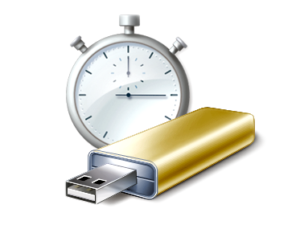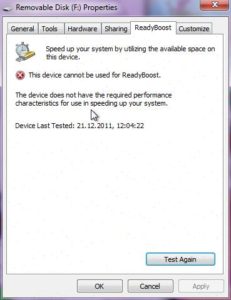ReadyBoost is a disk caching software which enables NAND memory mass storage devices, including CompactFlash, SD cards, and USB flash drives, to be used as a write cache between a hard drive and random access memory in an effort to increase computing performance. It relies on the SuperFetch technology and, like SuperFetch, adjusts its cache based on user activity.


Note – Computers with fast hard disks (such as 7,200- or 10,000-RPM disks) might realize minimal performance gains because of the already high disk I/O
ReadyBoost will not provide any performance gain when the primary disk is an SSD, Windows 7/10 disables ReadyBoost when reading from an SSD drive as windows 7/10 automatically detects the type of device attached and You’ll see the “ReadyBoost is not enabled because this computer is fast enough that ReadyBoost is unlikely to provide additional benefit” message in the ReadyBoost tab [See figure(a) below].


Figure (a) Figure (b)
In 32-bit versions of Windows Vista, 7, 8/8.1 and 10, and on FAT32 file system devices, one can use up to 4 GB of storage for ReadyBoost. Older FAT16 file system can also be used, but maximum cache size is limited to 2 GB.
You can convert FAT/FAT32 drives to NTFS file system, if one wants to use ReadyBoost cache larger than 2 or 4 gigabytes.
Windows Vista supports only one ReadyBoost drive at a time, Windows 7 and later allow combining up to 8 different removable devices. Therefore, in 64-bit Windows you can create ReadyBoost cache of up to 8 x 32 GB, or 256 GB in total.
How to use ReadyBoost :-
1. Insert removable media such as SD card, and USB flash drive.
2. Open “My Computer” on Windows 7 or “This PC” on Windows 10.
3. Right-click on inserted removable SD card or USB flash drive and select “Properties”.
4. Select the “ReadyBoost” tab
5. Select either “Dedicate this device to ReadyBoost” or “Use this device” radio button.
6. Drag the slider or type in desired amount (in MB) to be reserved for system speed which can be seen under section “Space to reserve for system speed”.
7. Click on “OK” button.
ReadyBoost will be activated for the preferred removable device.
Minimum requirements for ReadyBoost :-
- The removable media’s capacity must be at least 256 MB.
- Windows 7/10 allows up to eight devices for a maximum of 256 GB of additional memory, with up to 32 GB on a single storage device.
- The device must have an access time of 1 ms or less.
- The device must be capable of 2.5 MB/s read speeds for 4 kB random reads spread uniformly across the entire device, and 1.75 MB/s write speeds for 512 kB random writes spread uniformly across the device.
With Anakage intelligent training technology it is easier to learn these concepts . It guides you step by step on your system. Above topic being discussed is also part of our “Learning Application” for Microsoft Outlook 2013 which contains in application topics and many on the job assessment. If you want to evaluate it let us know by sending a mail to us at enterprise@anakage.in . You can know more about our offering for training.



0 Comments